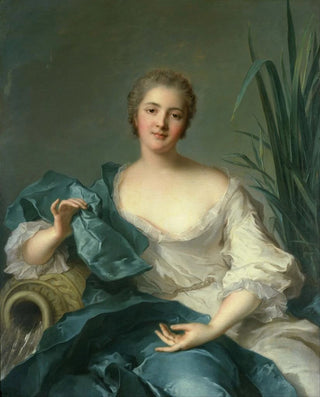Art print | Portrait of Madame Marie-Henriette Berthelot de Pléneuf - Jean-Marc Nattier


View from behind

Frame (optional)
Portrait of Madame Marie-Henriette Berthelot de Pléneuf - Jean-Marc Nattier – Captivating Introduction
In the fascinating world of 18th-century painting, the "Portrait of Madame Marie-Henriette Berthelot de Pléneuf" by Jean-Marc Nattier stands out for its elegance and psychological depth. This iconic artwork embodies the very essence of French portraiture of the era, where the depiction of individuals goes far beyond mere appearance. Through this canvas, Nattier does not merely capture his model’s face; he manages to reveal a part of her soul, an intimacy that transcends time. The finesse of details and the richness of colors transport us to a universe where each brushstroke seems to whisper a story.
Style and uniqueness of the work
Nattier’s style is characterized by unmatched delicacy, a mastery of light and shadow that gives his portraits an almost tactile dimension. In the "Portrait of Madame Marie-Henriette Berthelot de Pléneuf," the artist skillfully plays with drapery, highlighting the grace and movement of the sitter’s dress. The shades of blue and pink blend harmoniously, creating a soft and soothing atmosphere. Madame Berthelot’s pose, slightly turned toward the viewer, invites subtle interaction, as if she were about to share a secret. The carefully chosen background elements add narrative depth to the piece, evoking a world of refinement and culture, while anchoring the portrait within a specific social context.
The artist and his influence
Jean-Marc Nattier is often regarded as the portraitist of the elites of his time. Trained in the shadow of great masters, he developed a style that is uniquely his own, combining tradition and innovation. His psychological approach to portraiture allowed him to stand out in an artistic environment where superficiality was sometimes prevalent. Nattier was able to capture the essence of his models, endowing them with dignity and humanity that make them timeless. His influence extends beyond his own era, inspiring many subsequent artists who sought to blend technique and emotion in

Matte finish

View from behind

Frame (optional)
Portrait of Madame Marie-Henriette Berthelot de Pléneuf - Jean-Marc Nattier – Captivating Introduction
In the fascinating world of 18th-century painting, the "Portrait of Madame Marie-Henriette Berthelot de Pléneuf" by Jean-Marc Nattier stands out for its elegance and psychological depth. This iconic artwork embodies the very essence of French portraiture of the era, where the depiction of individuals goes far beyond mere appearance. Through this canvas, Nattier does not merely capture his model’s face; he manages to reveal a part of her soul, an intimacy that transcends time. The finesse of details and the richness of colors transport us to a universe where each brushstroke seems to whisper a story.
Style and uniqueness of the work
Nattier’s style is characterized by unmatched delicacy, a mastery of light and shadow that gives his portraits an almost tactile dimension. In the "Portrait of Madame Marie-Henriette Berthelot de Pléneuf," the artist skillfully plays with drapery, highlighting the grace and movement of the sitter’s dress. The shades of blue and pink blend harmoniously, creating a soft and soothing atmosphere. Madame Berthelot’s pose, slightly turned toward the viewer, invites subtle interaction, as if she were about to share a secret. The carefully chosen background elements add narrative depth to the piece, evoking a world of refinement and culture, while anchoring the portrait within a specific social context.
The artist and his influence
Jean-Marc Nattier is often regarded as the portraitist of the elites of his time. Trained in the shadow of great masters, he developed a style that is uniquely his own, combining tradition and innovation. His psychological approach to portraiture allowed him to stand out in an artistic environment where superficiality was sometimes prevalent. Nattier was able to capture the essence of his models, endowing them with dignity and humanity that make them timeless. His influence extends beyond his own era, inspiring many subsequent artists who sought to blend technique and emotion in






